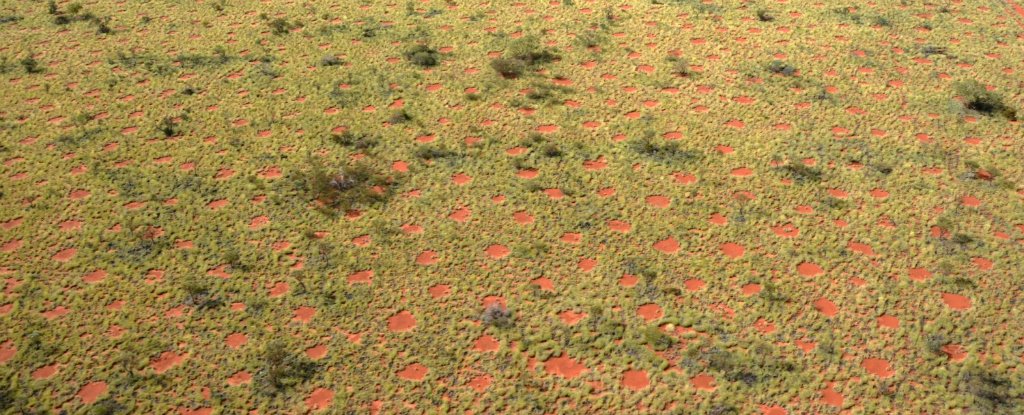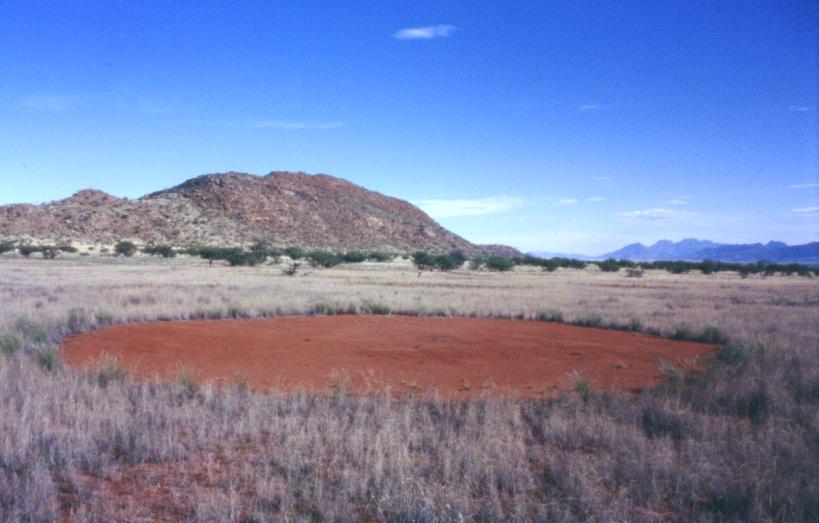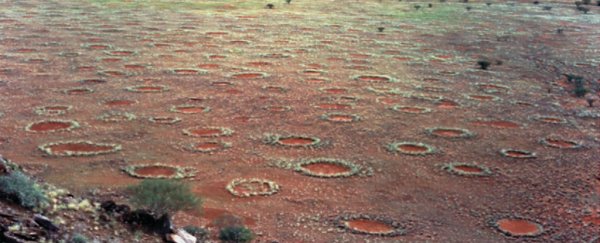Whenever something as deliberate and symmetrical as the fairy circles of Namibia crop up in nature, it's always a little unnerving - they look so carefully designed, coordinated, and almost intelligent in their construction.
The force behind these vast plains of polka-dotted sand have been a subject of debate for decades, but now scientists have come up with the best explanation yet. Turns out, these bare circles - ranging from a few centimetres to 25 metres in diameter - are the result of a permanent conflict going on beneath the Namib Desert.
If you're not familiar with this eerie natural phenomenon, in the arid grasslands of the Namib Desert in southern Africa, vast circle patterns have been appearing in the sand, and can remain there for up to 60 years.
The local Himba people refer to them as the footsteps of the gods, because of how stark and intentional they appear, and over the past few years, studies have narrowed down the possible explanations to two.
One popular hypothesis is that they are the handiwork of termites systematically munching on the grass above their nests, which made sense, seeing as more than 80 percent of Namibian fairy circles that have been investigated have had termites below.
But there's a problem - last year, scientists discovered that fairy circles aren't exclusive to the African desert. Some 10,000 km away in the Australian outback, fairy circles were discovered, and unlike the African circles, researchers found no evidence of termites.
 Australian fairy circles. Credit: Kevin Sanders
Australian fairy circles. Credit: Kevin Sanders
Instead, it was argued that these fairy circles are the result of the native grasses achieving some surprisingly sophisticated levels of self-organisation in one of the most inhospitable environments on Earth.
Now, ecologists from Princeton University say they've got an even better explanation - it's both.
"This is a classic thing in ecology where debates will emerge and go on for decades," one of the team, Rob Pringle, told Sarah Kaplan at The Washington Post.
"And the resolution after all that time is usually, 'Well, it's a little bit of both.'"
In an environment where nutrients are scarce, the inhabitants find themselves in constant conflict with each other to ensure the survival of their own species or colony.
Seeing as termites have been found beneath most Namibian fairy circles, researchers have argued that these bare patches are the result of termites eating the submerged roots, where the most moisture is accrued, and this kills off the vegetation on the surface.
But where competing colonies are forced to live next door, areas of untouched grass symbolise the borders that are maintained between opposing factions.
 A single, large fairy circle in Namibia. Credit: Thorsten Becker/Wikimedia
A single, large fairy circle in Namibia. Credit: Thorsten Becker/Wikimedia
"The termites start with their own mound and go out and forage. If they find a smaller colony, they simply kill it and expand their own territory," one of the researchers, Corina Tarnita, told The Guardian.
"But if they run into a colony that is about the same size, they cannot do that, and end up with a boundary where there's permanent conflict, but not a full-blown war."
This explanation makes total sense, but no one's actually caught the Namibian termites in the act of creating fairy circles. And you know what they say, correlation doesn't equal causation.
So the Princeton team set up a simulation of the Namib Desert environment to test out the hypothesis, and found that while the termites appear to be heavily involved in the construction of the fairy circles, they can't solely explain their appearance - especially when it comes to the Australian ones.
The next step was to include the plant hypothesis in the simulation.
The idea is similar to the termite hypothesis - in places where the vegetation is spread out, there's enough nutrients to go around fairly evenly. But in areas where the grasses are completing with each other for moisture, they'll send long roots out under the surface to steal the moisture from their distant neighbours.
This fierce competition for nutrients creates wide patches of sparse, dried out sand - but only temporarily, as Michael Byrne explains for Motherboard:
"[I]n conditions where nutrients are scarce, we can imagine patches of grass dying via intergrass competition, leaving circles that get progressively larger until the nutrient deficit is overcome.
The circles then allow rainwater to collect in them, which supplies more nutrients, which benefits everybody, including the termites. It all works out."
When the team ran this scenario through their simulation, it resulted in large-scale patterns of circles created by the termites, like the ones found in Namibia, and smaller circles in the vegetation between them, just like the termite-less patterns in Australia.
Observations in the field matched the results of their simulation perfectly.
"We found an exact agreement, as you zoom in you see these very striking patterns," Tarnita told The Guardian.
So… case closed? Not quite, because while this is the best explanation we've had so far, the researchers still haven't proven it - the next step is for scientists to actually witness this as it happens in the field.
But it does seem like the answer - even if it's a slightly different take on the plant and/or termite hypothesis - is pointing to these pock-like scars in the sand as stark reminders of the brutality of life in the desert.
The study has been published in Nature.
